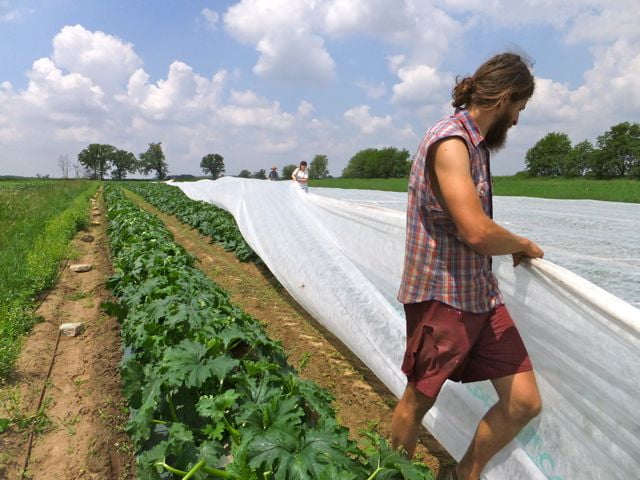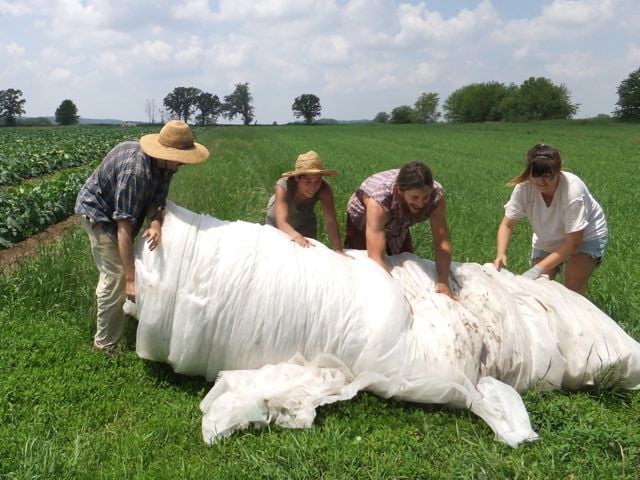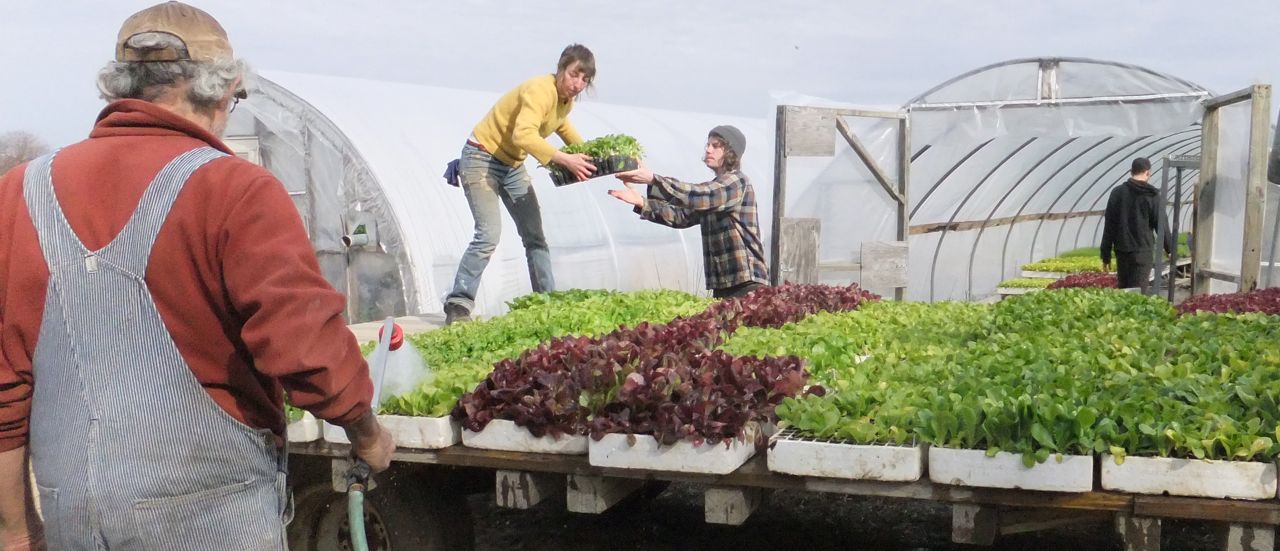Blog
Like folding a quilt
- On: June 12, 2013
 0
0
‘Twas time to unveil the zucchini field this week. We’ve kept the plants under row cover to speed their growth, but now it’s time to remove the covers to allow bees to pollinate the flowers. Big sheets of row cover are unwieldy. Our largest ones measure 50 feet by 500 feet, and cover more than a half acre. Here’s how to remove one from a field.
Step 1. Choose a calm, dry day. Wet row cover is astonishly heavy. Wind will carry it away.
Step 2. Gather a group of workers. Fold the cover lengthwise to remove it from the field. Fold repeatedly until the bundle is about 5 feet across. As Clint says “It’s like folding a quilt … a very big quilt.”
Step 3. Start to roll it up. One person can begin the roll but two are better.
Step 4. Add more helpers. By now the roll is getting heavy. Roll it quickly to make use of momentum.
Step 5. Finish the roll and collapse for a bit. Someone will carry the roll back to the buildings by tractor.
Member etiquette: Please scratch your name off the checkoff list.
It helps our site hosts identify unclaimed boxes. Thanks.
Scallion Ideas.
We are very enthusiastic about scallions at our house. Here are our favorite uses:
Scallion biscuits
*Scallion dumplings
Scallion pancakes
*Penne, spinach, asparagus and cashew salad, with scallion dressing
Egg drop soup with spring greens, topped with sliced scallions
*Grilled scallion, asparagus and turnip salad
Sliced scallions are good on sandwiches and salads
Grilled beef bulgogi wrapped in lettuce leaves. Easily adapted to tofu.
Salmon patties with scallions
* indicates the recipe is in the archives on our website
Veggie List and Veggie Notes.
Asparagus, 1.3 lb
Escarole, 1 head
Spinach, 1 medium bunch
White salad turnips with greens
Red bibb lettuce
Scallions, 1 bunch
Kohlrabi with greens OR broccoli, about 1 lb
Next week’s box will probably contain asparagus, peas, strawberries?, zucchini?, Swiss chard or other greens, broccoli OR kohlrabi and more.
Escarole (large green head that looks like lettuce) – This member of the chicory family can be eaten raw or cooked. Its slightly bitter flavor is a good addition to mixed salads. It is excellent cooked alone or mixed with other greens. It cooks quickly, but not as quickly as spinach. Refrigerate.
Spinach (small bundle of dark green leaves) – This is probably most useful for salad this week, as the quantity is small and leaves are tender. They will wilt down substantially when cooked. Plus there are all the other greens (turnip, escarole, and for some members kohlrabi) for cooking this week.
White salad turnips with greens (bundle of white roots with tops) – The turnip greens are tender again this week, and are good for cooking. Cook like mustard greens. The turnip roots are more abundant this week. There is minor insect damage on the roots this week, so some will need trimming.
Kohlrabi (round, pale green exterior, crisp white interior) – Kolrabi is an unusual vegetable that I enjoy introducing to new CSA members because almost everyone likes it. Crunchy and sweet, it’s a great addition to salads. Storage: Kohlrabi bulbs will store for a month in the refrigerator. Uses: Kohlrabi are good peeled and eaten out of hand, or added to sandwiches. It is good mixed into salads, or prepared as a salad on it’s own. You can grate it, slice it, or cut it into matchsticks. It’s also good cooked. If you have it, the Asparagus to Zucchini cookbook has a long list of kohlrabi suggestions.
The kohlrabi greens are quite nice this week and can be cooked. Steve tried a new variety with smaller, more tender leaves. Texture and waxiness are similar to young kale or collards. Cut out the midvein before cooking.
Remember, recipes and menus will be posted on the Local Thyme website each Thursday afternoon. Contact us if you need help setting up your account on the Local Thyme website.
Korean visitors
- On: June 05, 2013
 0
0
We hosted Korean visitors this week. It was an animated group of farmers, scientists and extension agents interested in organic agriculture. They asked many questions and wanted to touch everything. They were particularly interested in irrigation, cover crops, and the CSA. Their translator struggled to explain the CSA concept but they seemed to understand. We packed the CSA boxes with an attentive audience.
Steve showed them a field of pepper seedlings planted into rows covered with plastic mulch, similar to the onions in this post. Then he showed them the equipment he used to install the thin sheets of plastic, above. The translator could barely keep up with the questions and discussion.
Coopers Tavern dinner – Thanks to everyone who came to the Partner Shares benefit dinner at the Coopers Tavern. We enjoyed an excellent meal with current Tipi members, former Tipi members, former employees, food activists and old friends. My favorite dish was the pickled spring vegetable salad, a mix of individually pickled asparagus, radishes, bok choy stems and morel mushrooms. The asparagus was pickled in a fennel-scented brine, very yummy. The beer was donated by Peter Gentry of One Barrel Brewing Company. Peter was a member of our farm for many years, so it was fun to re-connect over our food and his beer.
This Week’s Box – I’ll list the box contents here (as well as in the sidebar) so it appears in the RSS feed and when printed. Weekly members and PURPLE every-other-week members get a box this week.
Asparagus, 1.25 lb
Spinach, medium bunch
White salad turnips with greens, 1 bunch
Romaine lettuce
Bok choy
Cilantro
Young scallions, 1 bunch
Rhubarb, 1.5 lb
Next week’s box will probably contain asparagus, white salad turnips, lettuce, scallions and more.
Veggie Notes
White salad turnips (bunched white roots with green tops) – I know that returning members look forward to these sweet and delicious turnips, which taste nothing like the turnips that are harvested in fall.
– Storage: Cover and refrigerate.
– Uses: Both the turnip roots and tops are edible. Slice the sweet roots and add to salads. They can be cooked and are especially good when lightly sauteed in butter. Stir as little as possible so they brown on at least one side. The turnips greens are excellent cooked. Treat them like mustard greens.
– Our favorite use: Slice the roots very thinly and combine with a mixture of rice vinegar, mirin, soy sauce, sesame oil. Eat immediately or marinate.
Bok choy (large rosette with thick white stems and green leaves) – This Asian green is good for stir-frying or sautéing or in soup. You can think of the stems and leaves as two separate vegetables. The stems require longer cooking. The leaves will cook almost as quickly as spinach. Bok choy stores well, so feel free to pull off leaves as you need them, or use the whole head at once. Refrigerate in a plastic bag.
– The plants started to bolt so we harvested them a bit younger than usual. You can eat the entire plant – cook the central stem with the leaf stems. Each spring, we face the decision of whether to cover the bok choy seedlings with row cover or not. They tend to bolt (flower prematurely) when under row cover, but get damaged by flea beetles if left unprotected. We tried both methods this spring. Wow, the uncovered ones were devoured by beetles. I’m glad we had these under cover.
Cilantro (bundle of fragrant green leaves) – This herb is good in salsa, chutneys and salad dressings, or added to stir-fries. Used in Mexican, Asian and Indian cooking. We are delighted to send cilantro in combination with bok choy and scallions because they are so tasty together.
Rhubarb – This is our last rhubarb delivery for a few weeks. We’ll send more once the strawberries are ready. Remember, rhubarb is easy to chop and freeze. We add frozen rhubarb to cakes, muffins, or pies. Rhubarb pancakes are excellent with sweetened yogurt.
The prettiest sight on the farm.
- On: May 29, 2013
 0
0
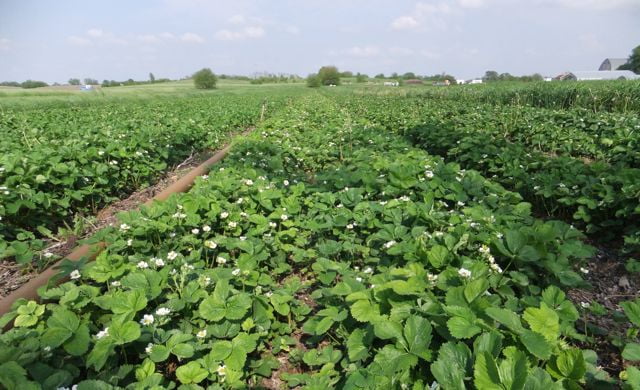
Strawberry plants in bloom. On frosty nights, we irrigate to protect the plants and blossoms, using the irrigation pipe at left.
That’s our strawberry field in full bloom. We tend a new strawberry field for a full year before the first harvest, so it’s exciting to see the plants survive the winter in good shape. We lost the entire strawberry crop last year. The plants broke dormancy too soon because of early warm weather, and the blossoms were killed by frost despite our efforts to protect them. Let’s keep our fingers crossed for this year.
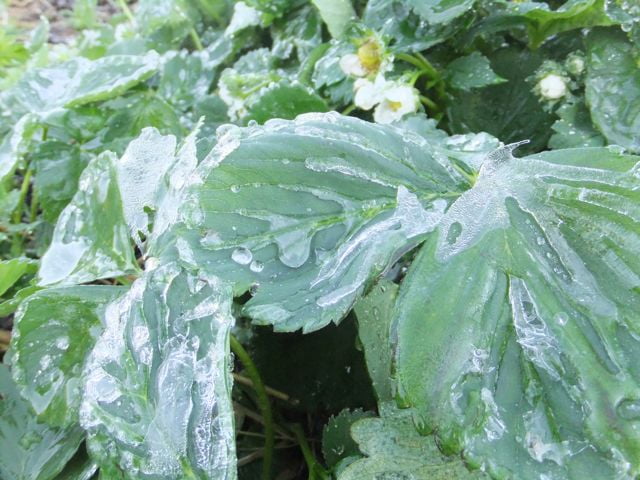
Strawberry leaves covered in ice after we irrigated early Friday morning to protect from frost.
As water crystallizes into ice, it releases heat which keeps the plants safely at 32o F.
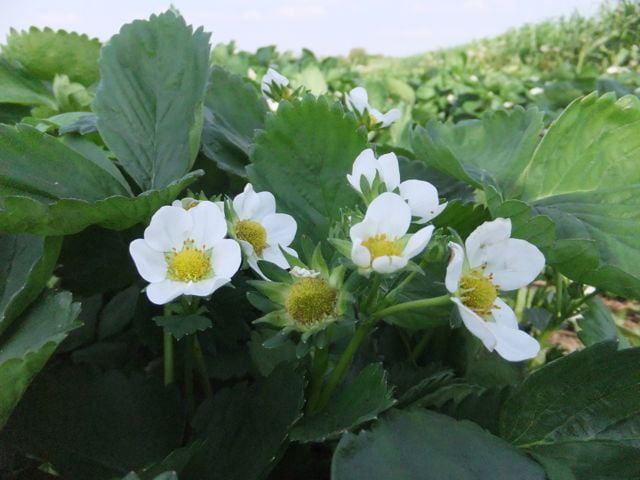
The irrigation worked and the blossoms were not damaged. At center is a flower whose petals have dropped. You can see the developing green strawberry.
I will deposit June 1 checks on June 4.
Many of you paid with checks post-dated to June 1. Remember? I will deposit them on Tuesday June 4 so everyone has enough time to adjust their account balances. If you are uncertain of your check dates, you can send yourself a receipt that lists your payments by date.
CSA shares still available.
We have 17 shares still for sale. There’s room at all sites except Atwood, Buckeye and the Outpost in Wauwatosa. We would especially like to find new members for our site at the Outpost on Kinnickinnic Ave. in Milwaukee. Tell your friends. We’re eager to settle the membership and focus on farming. Thank you.
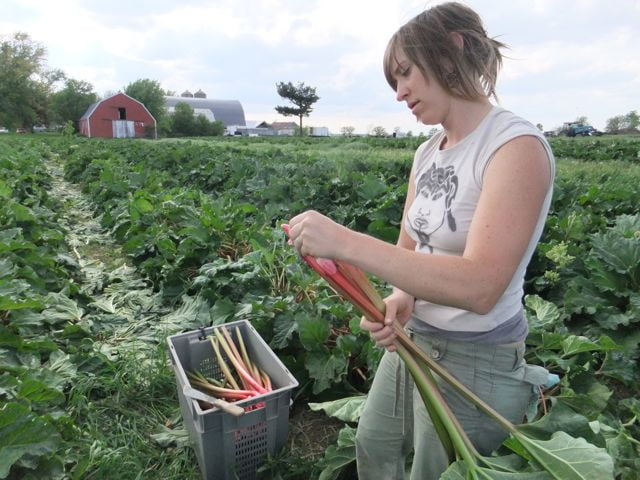
Bonnie trims rhubarb stalks. Note the slew of trimmed leaves in the row behind her. Our field consists of 12 rows but we only needed three rows to fill the CSA boxes last week. Wow.
Veggie Notes. The big story this week is rhubarb. We divide and refresh our rhubarb plantings every five to eight years to keep the plants growing strongly. Rhubarb stalks get thinner and thinner as the crowns become crowded. Early this spring, Steve mused that might be a problem this year. Ha! This is the most vigorous rhubarb growth we’ve ever seen. We had to cut the stalks in half so they will fit in the CSA boxes. We plan to send rhubarb again next week because of the bounty.
Asparagus – See last week’s newsletter for info on storage and preparation.
Rhubarb – FYI, rhubarb freezes beautifully. Chop into chunks and freeze in a bag. No need to blanch. You can also freeze rhubarb sauce. See last week’s newsletter for more info about rhubarb.
Parsnips (long white roots) – We had a bumper crop of parsnips last fall, so we stored these over the winter for the spring boxes. Those long, white roots are not carrots, they are parsnips. The two vegetables are related. Unlike carrots, parsnips are rarely eaten raw. When cooked, parsnips are sweet and starchy. Brown them so the sugars caramelize, to give the best flavor. Here are a few ideas about how to prepare parsnips:
– Caramelize the parsnips by roasting them in a vegetable medley.
– Parsnip fries are delicious: cut like French fries, coat very lightly with oil, place on a cookie sheet and roast in a hot oven until cooked through and browned. Farm cook Lacey made those for us this week.
– Substitute grated parsnips in a potato pancake recipe. They brown beautifully and are very tasty.
– We often pan-fry onions with onions and garlic.
Button mushrooms – These organic mushrooms are from the folks at Hidden Valley Mushrooms in the Wisconsin Dells. We often buy mushrooms from them for our spring boxes. They enliven spring salads when our crop list is short.
Mustard greens (small bundle of flat green leaves) – These are “salad quality” mustard greens, so young and tender that you can use them raw in salads. They are excellent cooked until wilted, but will shrink considerably.
Lettuce – The lettuce is still very young and tender. Handle carefully.
Ready, set, eat.
- On: May 22, 2013
 0
0
Deliveries begin. Yeah!
Our CSA deliveries begin this week for weekly members and for PURPLE every-other-week (EOW) members. GREEN EOW members, your first delivery is next week.
We are thrilled the season has finally begun. It was a slow, cool start. We planned to begin deliveries on May 16, but pushed them to May 23 to let the crops grow. Our greenhouses were bursting with seedlings. Once the weather cleared, we hurried to get the plants in the ground.
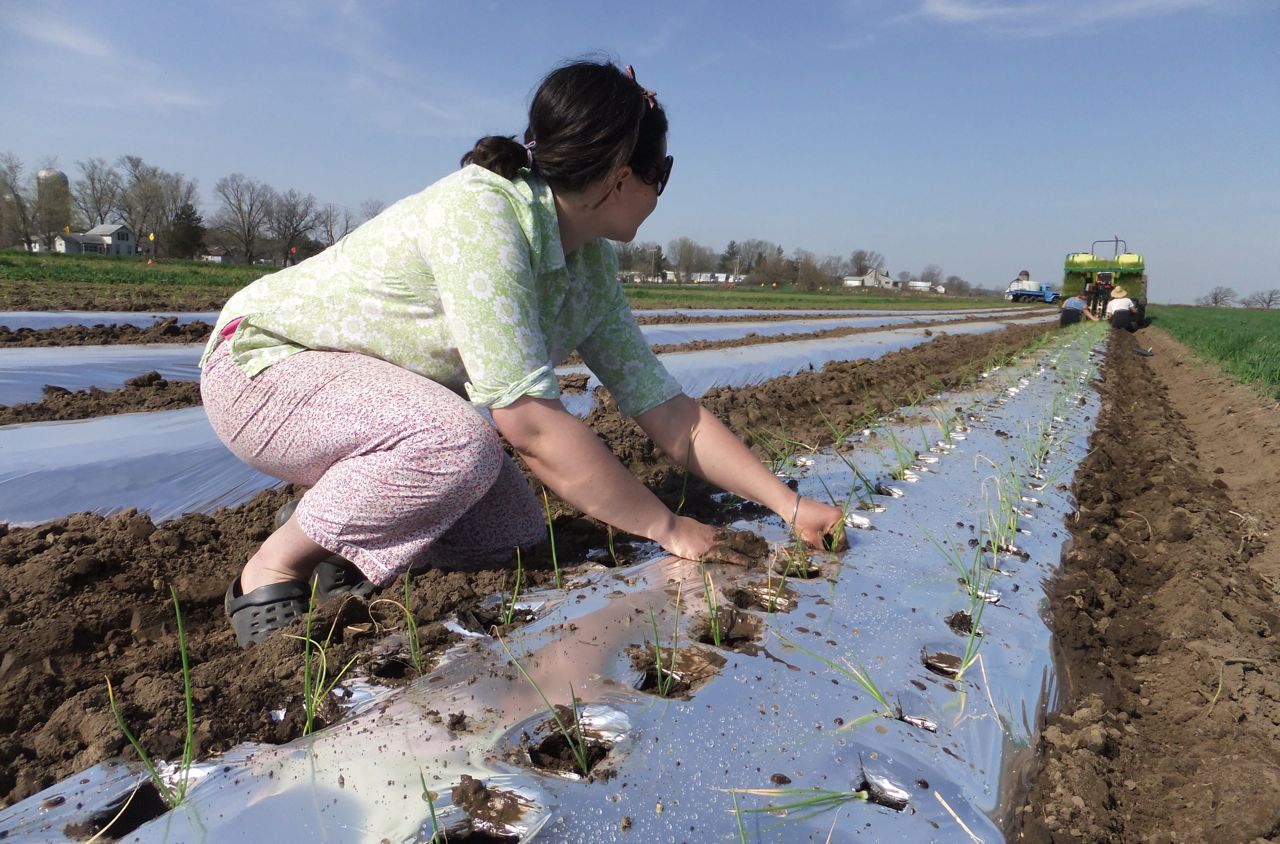
Carla transplants onions and realizes the transplanter has gotten too far ahead.
Transplanting requires teamwork. One group rides the transplanter and lays out the seedlings, while another group plants them in the ground. The second group stays close to the transplanter in case there are problems. We upgraded to a newer, faster transplanter this year, which threw our pace off. We continue to experiment with reflective silver mulch to control insect problems in our onion crop. It’s an interesting no-spray approach to a problem we face each season.
Tipi Facts: Things you need to know.
♦ Recipes will be on the Local Thyme website this year, instead of in our newsletter.
♦ The first few boxes of the season are always the lightest. Every-other-week (EOW) members, please do not worry that you have signed up for the wrong share. Later deliveries will be larger.
♦ We post our newsletter online each Wednesday night, then send a reminder email.
♦ EOW and weekly members, we assume that you read all the newsletters, even on your “off” weeks. We rely on the newsletter to communicate with everyone. You do not want to miss important information about the veggies, or a farm event announcement, or an opportunity to purchase extra tomatoes or peppers.
Local Thyme menu service = New this year.
We are excited about this change. We hired Pat Mulvey and Laura Gilliam of Local Thyme to prepare menus and recipes for our CSA this year. I’ve cooked extensively with their recipes and find them quick and delicious. We provide this service free-of-charge in 2013 to help you enjoy all your CSA produce, with less veggie waste. We hope you enjoy it.
♦ They will provide three menus: omnivore (ie, no dietary restrictions), vegetarian and gluten-free. Members can view all three menus.
♦ The menus will be customized to use every item in your box.
♦ Check out their weekly shopping lists, cooking tips and vegetable advice. Their searchable recipe archive is extensive.
♦ The menus and recipes will be housed on their website. You have to register on their website. Go to www.localthyme.net/register and enter the access code that I sent in my May 22 email. Pat and Laura work hard on their recipes, so access is restricted to Tipi members. Please don’t share the website with friends.
♦ Once registered, you’ll receive their Thursday afternoon announcement when the menus are ready.
♦ Their website will be available to us for one full year, so use it in winter too.
♦ A Tipi member with access to Local Thyme last year wrote “It was great for me. Menu planning is an additional task I usually don’t have time for. We end up wasting produce or using the same recipes that I feel are safe. It allowed me to show up at my pick-up site with a shopping list in hand of everything else I needed.” That sums up our hopes for the service.
 Plough and Barrel Dinner.
Plough and Barrel Dinner.
Coopers Tavern is hosting a fund-raising dinner for Partner Shares on June 3. See my previous post for details.
Veggie Notes. Check this section each week for information about the veggies in the box. I’ll provide extra info on cooking and storage the first week that we send a vegetable. Does an item need extra washing? Does it have special qualities? This is the place to find out. For example, please, please refrigerate the potatoes. We explain the reason below.
Asparagus – This is the most asparagus we’ve every sent in one delivery. Enjoy this spring treat! You will receive either green or purple asparagus. The purple variety will turn dark green when cooked, and the flavor is almost identical to normal green asparagus. The best way to wash asparagus is to submerge it in water, soak briefly, then swish vigorously and pull out of the water with the tips pointing down. The draining action helps pull the grit out of the asparagus tips. Repeat several times.
Storage: Asparagus is perishable, so eat it as soon as possible. To store it, wrap the bundle in a paper towel and then store it loosely in a plastic bag. The asparagus tips tend to rot if in direct contact with the plastic bag. We snap our asparagus at harvest, rather than cutting it. Therefore, there is no need to snap the stalks to remove fibrous ends. For the same reason, it is not necessary to peel the asparagus stalks. It’s OK to trim the end a bit.
Cooking: If your asparagus stalks vary greatly in size, you will want to cook the thicker ones longer. Put the asparagus in a steamer pot over water. Alternatively, you can lay spears flat in the bottom of a broad pan, with ½ inch of water. Cover and steam over medium heat until just tender. Use two forks or a spatula to turn the asparagus during cooking, rotating the bottom spears to the top. Drain and serve. Also excellent broiled or grilled. Good dressed with vinaigrette. We always eat our first asparagus dressed with lime juice, salt and pepper.
Rhubarb – Refrigerate in a plastic bag. FYI, 2 lb of rhubarb will yield about 6 to 6.5 cups when chopped.
Stewed rhubarb: This is the simplest way to prepare rhubarb. Chop rhubarb into one inch chunks. Stir over medium heat with a small amount of water in the bottom of the pan. The rhubarb will release moisture as it cooks. Stew until it softens and falls apart. Sweeten to taste with honey or sugar. Eat warm on its own, over vanilla ice cream, on pancakes, etc.
Potatoes – You will receive white Superior potatoes or Gold Rush russets. Please refrigerate these potatoes. They are in great shape now but will sprout within days if stored at room temperature. They’ve been stored all winter and want to grow! Store in a paper bag to protect from light, even in the fridge. We grow everything we send in our CSA boxes except potatoes, garlic and mushrooms, which we buy from organic growers that we trust. We purchased these potatoes from Jesse Perkins at Vermont Valley Farm. Jesse says the potatoes have a higher sugar content because of starch to sugar conversion during cold storage. The potatoes taste a bit sweet, and will blacken slightly when fried. It’s a harmless color change due to the sugar conversion.
Green garlic – (looks like scallions) – Steve planted 50% more green garlic than usual last fall. I wondered at the time if it was wise. Well, it was brilliant. This winter was hard on garlic. Every farmer I know lost a portion of their garlic planting over the winter, probably due to freezing and thawing cycles. I’m glad we have enough green garlic for everyone this week. That’s it until garlic scapes are ready to harvest.
♦ The cloves we planted last fall sprouted and grew into the stalks we’ve sent today. If left to grow, the slim white bulb on this week’s garlic would divide and form the usual cluster of cloves in a garlic bulb. Green garlic is more pungent than scallions, so slice thinly and use sparingly when raw. It mellows when cooked. Chop and add to any cooked dish that would benefit from garlic. Use the white bulbs and pale green stems. Avoid the dark green stems and leaves, as these are fibrous.
Arugula – (small bunch of green leaves with pungent scent) – This is good mixed with lettuce or spinach in salads or in cooked dishes such as lasagne or quiche. I love it on sandwiches This batch of arugula has begun to bolt (stretch into a flower stalk) but remains tender and good eating quality. It is thin-leaved and will not store for long. Eat soon. Cover and refrigerate.
———————————————
Local Thyme will send an email on Thursday afternoon once the menus are ready to view.
Come to dinner with us.
- On: May 21, 2013
 0
0

Hi Tipi members,
Coopers Tavern is hosting a fund-raising dinner using our produce to raise money for the beloved Partner Shares program which supports CSA shares for low-income households. Steve and I will be there! Come join us. Here are the details:
- Monday June 3, 6:00 p.m.
- 3-course dinner featuring spring produce from our farm and Parisi Family Farm, paired with beer from One Barrel Brewing
- Coopers Tavern, at 20 West Mifflin Street, Madison
- $50 per person
- Reservations and payment can be made in person at Coopers Tavern, or by calling (608) 256-1600, or by emailing Jennifer Trost at [email protected]. Seating is limited.
I can’t wait to see what they prepare.
Beth
2013 CSA Handbooks
- On: May 21, 2013
 0
0
Tipi members, our deliveries begin this week. Please read our CSA Handbooks, Parts 1 and 2 before you pick up your first box. We sent the Handbooks by email on May 13 (Thursday sites) or May 14 (Friday sites). Let us know if you need another copy. Your share type determines your schedule. Not sure of your share type or EOW color? Send yourself an email with the info. Our 2013 schedules are listed in our 5/18/13 post below. Thanks!
2013 Schedules
- On: May 18, 2013
 0
0
Delivery Schedule for Thursday pick-up sites.
Evansville, Madison, Middleton, and Oregon locations
Weekly members, 26 weeks
May 23, May 30, June 6, June 13, June 20, June 27, Wed. July 3, July 11, July 18, July 25, August 1, August 8, August 15, August 22, August 29, September 5, September 12, September 19, September 26, October 3, October 10, October 17, October 24, October 31, November 7, November 14
Every-other-week members, PURPLE GROUP, 13 weeks
May 23, June 6, June 20, Wed. July 3, July 18, August 1, August 15, August 29, September 12, September 26, October 10, October 24, November 7
Every-other-week members, GREEN GROUP, 13 weeks
May 30, June 13, June 27, July 11, July 25, August 8, August 22, September 5, September 19, October 3, October 17, October 31, November 14
Delivery Schedule for Friday Pick-up Sites.
Janesville, Milwaukee and Wauwatosa locations
Weekly members, 26 weeks
May 24, May 31, June 7, June 14, June 21, June 28, July 5, July 12, July 19, July 26, August 2, August 9, August 16, August 23, August 30, September 6, September 13, September 20, September 27, October 4, October 11, October 18, October 25, November 1, November 8, November 15
Every-other-week members, PURPLE GROUP, 13 weeks
May 24, June 7, June 21, July 5, July 19, August 2, August 16, August 30, September 13, September 27, October 11, October 25, November 8
Every-other-week members, GREEN GROUP, 13 weeks
May 31, June 14, June 28, July 12, July 26, August 9, August 23, September 6, September 20, October 4, October 18, November 1, November 15
Plants in the ground.
- On: April 24, 2013
 0
0
- Steve waters the lettuce seedlings while Kerry and Michael prepare for transplanting
It stopped raining long enough to us to work in the fields on Monday. We transplanted lettuce, spinach, scallions, bok choy, and greens. That’s a lot for one day but we didn’t know when there would be another opportunity. Plus we needed to clear room in our crowded greenhouses for more seedings.
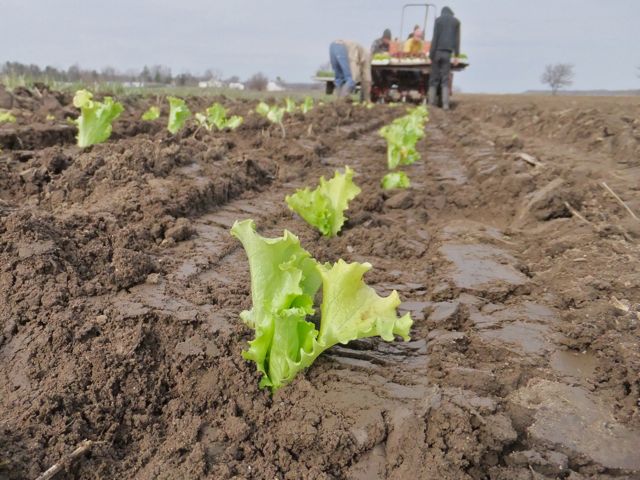
The ground was just dry enough to work.

